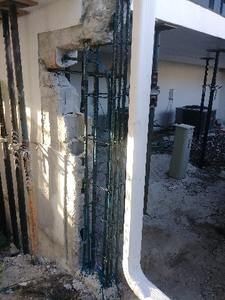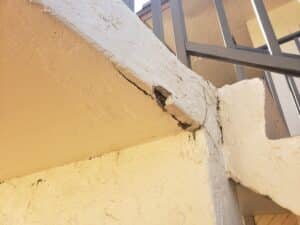In the world of commercial high-rise buildings, waterproofing and sealants play a vital role in maintaining the structure’s integrity and preventing potential damage caused by water leaks or seepage. As water intrusion can quickly deteriorate the building materials and compromise the foundation, it’s essential to have proper waterproofing systems and sealants in place to avoid costly repairs, liabilities, and health hazards. At McLeod’s Contracting Solutions, we understand the importance of these services and provide expert solutions to help preserve your commercial property.
Waterproofing, a process used to make a structure impenetrable by water, is crucial for commercial high-rise buildings given their increased exposure to environmental conditions such as rain, moisture, and humidity. A properly installed waterproofing system not only protects the structural elements of a building but also prevents mold and mildew growth, essential to maintain a healthy environment for occupants.
Sealants, on the other hand, are materials used to close gaps, joints, and openings in buildings to mitigate the infiltration of water and air. Additionally, sealants serve aesthetic purposes and contribute to the building’s longevity by preventing regular wear and tear. High-rise commercial properties, with their abundance of windows, doors, and expansion joints, require the appropriate sealant applications to ensure durability and maintain a pristine appearance.
This essential guide will provide comprehensive information on the importance of waterproofing and sealants in commercial high-rise structures. We will delve into various aspects of these services, from the types of waterproofing and sealants available to the benefits they provide, common problems associated with improper water management, and how McLeod’s Contracting Solutions can help you maintain and protect your property.
Stay tuned as we explore different types of articles, like guides, checklists, FAQs, and expert advice to give you all the information you need about waterproofing and sealants in commercial high-rise buildings. Be sure to bookmark our blog and stay educated about the latest industry trends and best practices.
The Essential Guide to Waterproofing and Sealants in Commercial High-Rise Buildings
Types of Waterproofing Systems
There are several types of waterproofing systems used in commercial high-rise buildings, each designed to address specific needs and requirements. The most common types include:
1. Liquid Applied Waterproofing: As the name suggests, this type of waterproofing involves applying a liquid membrane on the surface, which cures to form a monolithic, fully adhered membrane. Liquid applied waterproofing is suitable for roofs, balconies, and podium decks due to its versatility and ease of application.
2. Sheet Membranes: Composed of rubber, thermoplastics, or modified bitumen, sheet membranes are preformed layers that are bonded to building structures using adhesives or heat welding. They are commonly used in basement and foundation walls to resist water penetration and protect the structure from deterioration.
3. Cementitious Waterproofing: This is a rigid waterproofing system made from cement-based materials mixed with water-resistant additives. Cementitious waterproofing is commonly used in areas exposed to dampness, such as swimming pools, balconies, and water tanks.
4. Bentonite Clay Waterproofing: Utilizing the natural water-absorbing properties of sodium bentonite clay, this type of waterproofing creates a barrier that swells upon contact with water, sealing off leaks and cracks. It is commonly used in foundations and underground structures.
Types of Sealants
Sealants, as essential components of waterproofing systems, come in various forms, each designed to cater to different applications:
1. Silicone Sealants: Known for their flexibility and durability, silicone sealants provide excellent weather resistance and UV stability. They are commonly used for sealing joints in glass, aluminum, and curtain wall construction.
2. Polyurethane Sealants: With exceptional adhesion to a variety of substrates and excellent resistance to water, chemicals, and abrasion, polyurethane sealants are suitable for sealing expansion joints, concrete panel joints, and window and door perimeters.
3. Polysulfide Sealants: Boasting high elongation and strong resistance to most chemicals, including fuels, polysulfide sealants are commonly used in industrial and petrochemical facilities for sealing joints exposed to harsh environments.
4. Acrylic Sealants: With good UV resistance and paintability, acrylic sealants are well-suited for sealing joints in interior and exterior applications, such as around windows and doors, and in masonry or stucco surfaces.
Benefits of Proper Waterproofing and Sealants Applications
Implementing appropriate waterproofing systems and sealants offers various benefits for commercial high-rise buildings:
1. Protection against water damage: Properly executed waterproofing and sealant applications help prevent water infiltration that can lead to structural deterioration, mold and mildew growth, and damage to interior contents.
2. Safety enhancement: Waterproofing reduces the risk of slips and falls caused by wet surfaces and helps control the moisture levels within the building, preventing condensation and associated problems.
3. Energy efficiency: A well-sealed building envelope significantly improves energy efficiency by minimizing air leakage, which leads to reduced energy consumption for heating and cooling purposes.
4. Increased property value: Effective waterproofing and sealant applications help maintain a building’s structural integrity and appearance, ultimately increasing its market value by preventing costly repairs.
Common Waterproofing and Sealants Pitfalls
Several issues can arise from inadequate waterproofing and sealant applications:
1. Incompatibility of materials: Using incompatible materials can cause premature failure of the waterproofing system or sealants, leading to water penetration and associated problems.
2. Insufficient surface preparation: Proper surface preparation, such as cleaning and priming, is crucial for the success of waterproofing and sealant applications. Failure to follow this step can result in poor adhesion and overall performance.
3. Improper installation: Incorrect installation techniques, lack of necessary equipment, or inadequate knowledge can lead to poor waterproofing or sealant performance and eventually to water infiltration.
4. Ignoring maintenance: Regular inspection and maintenance of waterproofing systems and sealants are necessary to ensure their performance and longevity.
Conclusion:
Waterproofing and sealants play a crucial role in maintaining the integrity, safety, and durability of commercial high-rise buildings. By understanding the different types of systems, their benefits, and potential pitfalls, property owners and managers can make informed decisions to protect their valuable assets. McLeod’s Contracting Solutions offers expert services for waterproofing, sealants, and other essential building maintenance applications to ensure your commercial high-rise property remains in top condition. Contact us today to learn more about our top-quality services and to schedule a professional inspection.







